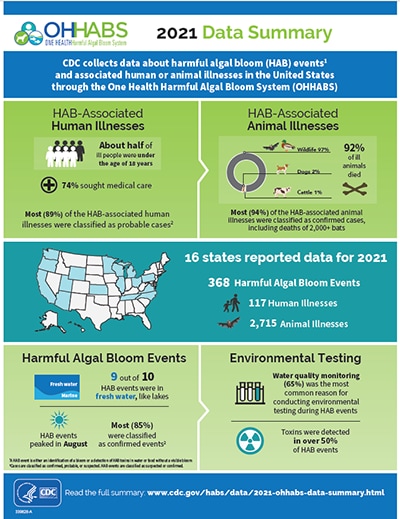Summary Report – One Health Harmful Algal Bloom System (OHHABS), United States, 2021
Highlights
- Sixteen states voluntarily reported 368 harmful algal blooms (HABs) that resulted in a total of 117 human illnesses and at least 2,715 animal illnesses.
- HAB events predominantly occurred in summer months, peaking in August (92; 25%), and most (90%) of the 368 HAB events occurred in freshwater bodies such as lakes and reservoirs.
- Human illnesses occurred primarily in June (38; 33%), and the most commonly reported signs and symptoms were gastrointestinal, generalized (e.g., headache, fever), and dermatologic.
- Animal illnesses occurred primarily in August (2,328; 86%) and mostly involved wildlife, including a mortality event that killed at least 2,000 bats.
- The most commonly reported signs in animals were genitourinary (e.g., dark urine) in wildlife, followed by gastrointestinal (e.g., vomiting) and generalized (e.g., lethargy) in domestic pets.
- Most HAB events were classified as confirmed (85%), human illnesses as probable (89%), and animal illnesses as confirmed (74%).
Harmful algal blooms (HABs) that result from the rapid growth of algae or cyanobacteria (also referred to as blue-green algae) in natural waterbodies can harm people, animals, or the environment. HAB events of public health concern are primarily caused by microalgae (e.g., diatoms and dinoflagellates), cyanobacteria, and the toxins they can produce. HAB events, which can be intensified by factors such as nutrient pollution and warmer water temperature, can have public health, environmental, and economic impacts.
HABs are a One Health issue—they affect the health of people, animals, and our shared environment. One Health is a collaborative and multisectoral approach that involves engagement across disciplines including public health, animal health, and environmental health. Using a One Health approach, CDC collects data about HAB events and associated human or animal illnesses through the One Health Harmful Algal Bloom System (OHHABS) to inform public health prevention efforts.
In OHHABS, the term HAB event means either identification of a bloom or the detection of HAB toxins in water or food without a visual bloom. Human illnesses are reported individually. Animal illnesses are reported as single cases of illness or in groups, such as flocks of birds or schools of fish. The reporting system can link HAB event data with human or animal illness data. OHHABS uses standard definitions [PDF – 3 pages] to classify HAB events as suspected or confirmed and human or animal illness as suspected, probable, or confirmed.
OHHABS is available for voluntary reporting by public health agencies and their designated environmental health or animal health partners in the United States, District of Columbia, Federated States of Micronesia, Guam, Marshall Islands, Northern Mariana Islands, Palau, Puerto Rico, and U.S. Virgin Islands. Public health agencies use standard forms to report HAB events, human cases of illness, and animal cases of illness to OHHABS. Public health agencies do not need to submit all three types of forms to participate.
Data collected for HAB events include general information (e.g., observation date), geographic information, water body characteristics (e.g., salinity), observational characteristics (e.g., water color, presence or absence of scum), and laboratory testing results. Data collected for cases of illness include general demographic characteristics, exposure information, signs and symptoms, medical care, and health outcomes. OHHABS is a dynamic electronic reporting system; data within individual reports are subject to change over time. Data included in this report are from a specific point in time.
This summary describes data from OHHABS for events occurring between January 1, 2021 and December 31, 2021. Reports were received by October 3, 2022 and reviewed by CDC using standardized data quality checks. CDC downloaded the final dataset on January 30, 2023. CDC used SAS (version 9.4; SAS Institute) to conduct descriptive analyses to characterize HAB events and associated human or animal cases of illness.
This summary reflects a change in methodology to analyses involving environmental laboratory results. In prior summaries, a result was included as a “positive detection” if the reported concentration was greater than zero (>0) or there was no reported concentration (e.g., a toxin was reported but not the concentration). Reported concentrations of 0 were considered “non-detections” and not included. Beginning with the 2021 annual summary, a concentration >0 is required for the result to be counted as a positive detection and included in analyses.
If group animal reports were missing the number of individuals affected, the number was set to two for inclusion in descriptive analyses. If group animal reports indicated deaths occurred but did not provide the number of individuals that died, the number of deaths was set to missing as this could not be extrapolated from available information.
Public health agencies classified HAB events as suspected or confirmed and cases of illness as suspected, probable, or confirmed (2018 OHHABS case and event definitions [PDF – 3 pages]). Animals within group animal reports were classified according to the overall classification (e.g., if a group of 10 animals was classified as “probable,” then each animal was subsequently defined as a probable case of illness).
Reported signs and symptoms were classified primarily based on the organ system affected. “Generalized” refers to constitutional signs and symptoms such as headache, fever, or lethargy in humans and weakness, lethargy, or anorexia in animals. Some signs and symptoms classified as neurologic may present in other systems (e.g., ophthalmologic). Signs and symptoms reported in OHHABS are reviewed periodically to assign classifications to newly entered values.
Overview
During 2021, 368 HAB events were reported by 16 state jurisdictions: Arizona, California, Illinois, Kansas, Michigan, Minnesota, North Carolina, Ohio, Oregon, Pennsylvania, Tennessee, Utah, Virginia, Washington, Wisconsin, and Wyoming (Figure 1). These HAB events resulted in 117 human cases of illness and at least 2,715 animal cases of illness. Twenty-one groups of animals were reported, ranging in size from 2–2,000 individuals. (Figure 2)
Reported HAB events occurred predominantly in summer months, peaking in August (92; 25%) (Figure 3) and were most often classified as confirmed (311; 85%) (Figure 4). Human cases of illness occurred primarily in June (38; 33%). Animal cases of illness occurred primarily in August (2,328; 86%). Case classification differed between human and animal cases of illness; the majority (104; 89%) of human cases of illness were classified as probable and 2,018 (74%) animal illnesses as confirmed (Figure 4).
Figure 4. Proportion of reported HAB events and associated human and animal cases by classification, 2021
In 2021, 85% of HAB events were classified as confirmed, 89% of human illnesses as probable, and 74% of animal illnesses as confirmed. When a large mortality event was excluded, 94% of animal illnesses were classified as probable.
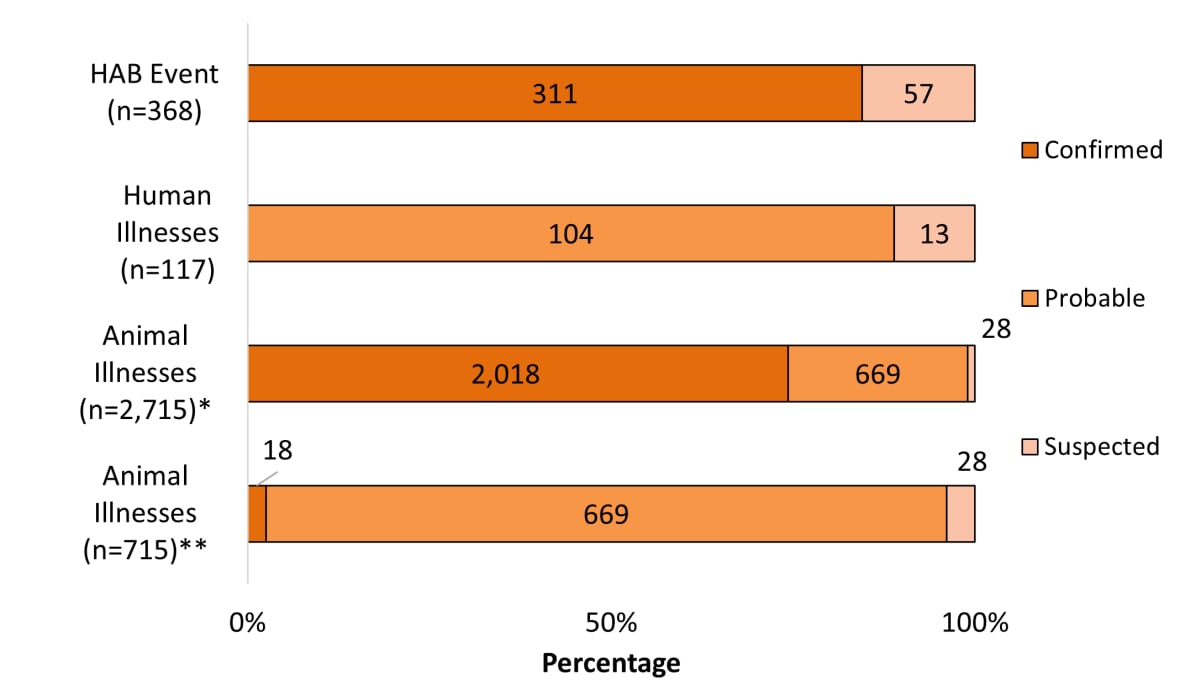
*Including a large bat mortality event (at least 2,000 bats) in August.
**Excluding a large bat mortality event (at least 2,000 bats) in August.
HAB events can only be classified as “suspected” or “confirmed.”
| Confirmed – Frequency (%) | Probable – Frequency (%) | Suspected – Frequency (%) | Total – Frequency (%) | |
|---|---|---|---|---|
| Animal Illnesses** | 18 (3) | 669 (94) | 28 (4) | 715 (100) |
| Animal Illnesses* | 2,108 (74) | 669 (25) | 28 (1) | 2,715 (100) |
| Human Illnesses | 0 (0) | 104 (89) | 13 (11) | 117 (100) |
| HAB Event | 311 (85) | 0 (0) | 57 (15) | 368 (100) |
HAB Events
Most (330; 90%) of the 368 HAB events occurred in fresh water (Figure 5a), primarily in lakes, reservoirs, or impoundments (83%) (Figure 5b). Within the freshwater HAB event subset, observers most frequently noted green water color (27%), however, one or more observations of clear water were reported during 10% of these HAB events (Figure 6). Scum or algal matter was observed in 199 of 218 (91%) HAB events that included information on scum presence or absence.
Monitoring (65%) and citizen complaints (23%) were the most frequently reported reasons for conducting environmental testing for algal toxins or species (Figure 7). Most reports (280; 76%) included environmental testing results with positive detections (>0) of cyanobacteria, algae, or toxins and almost all of these were related to freshwater HAB events (94%). Among these 280 reports, toxins were most frequently detected (186; 66%), followed by cyanobacteria or algae (121; 43%) (Figure 8). Toxin testing primarily identified microcystins (166; 89%) (Figure 9a); multiple toxins were reported for 27 HAB events. Aphanizomenon was the genus most frequently identified during environmental testing, detected in 37 HAB events (Figure 9b). Pseudo-nitzschia was the only genus identified in marine coastal waters during eight HAB events.
Figure 9b. Identified genera during environmental testing of HAB events, 2021
Aphanizomenon was the most commonly identified genus during environmental testing, detected in 37 HAB events (30%).

Multiple options could be selected.
| Genera | Frequency | (%) |
|---|---|---|
| Nostoc | 1 | (0) |
| Lyngbya | 2 | (2) |
| Phormidium | 2 | (2) |
| Anabaena | 3 | (2) |
| Pseudo-nitzschia | 8 | (7) |
| Planktothrix | 8 | (7) |
| Cylindrospermopsis | 9 | (7) |
| Unknown (Cyanobacteria) | 10 | (8) |
| Microcystis | 19 | (16) |
| Other (Diatoms) | 36 | (30) |
| Other (Dinoflagellate) | 36 | (30) |
| Other (Cyanobacteria) | 36 | (30) |
| Aphanizomenon | 37 | (30) |
Human Illnesses
Of 117 human cases of illness reported to OHHABS for 2021, 45 (38%) illnesses occurred in adults aged 18-45 years and 54 (46%) illnesses occurred in people under age 18 (Figure 10). People who became ill were exposed to HABs predominately at public outdoor areas (38%) and beaches (30%). Nearly all (89%) of the 117 people who became ill reported water and 7% reported air as a source of exposure (multiple sources were reported in 1% of illnesses). People sought care in 86 (74%) instances; over half (59%) called a poison control center, and 8% of illnesses resulted in an emergency department visit (Table 1). No deaths were reported.
Numerous signs and symptoms were reported; the most commonly reported types were gastrointestinal (59%), generalized (43%), and dermatologic (31%) (Figure 11). Overall, diarrhea (37%) and vomiting (33%) were the most commonly reported signs and symptoms (Table 2). Median time to illness onset was 12 hours (0–96; n=76) and median illness duration was 24 hours (0.50-720; n=63); 50% of ill people still exhibited signs or symptoms at the time of interview (Table 1).
| Health-seeking behavior | Number | (%) |
|---|---|---|
| Any health-seeking behavior | 86 | (74) |
| Call to a poison control center | 69 | (59) |
| Visit to healthcare provider | 21 | (18) |
| Visit to emergency department | 9 | (8) |
| Received first aid care | 1 | (1) |
| Experiencing symptoms at time of interview | 58 | (50) |
| Classification | Sign or Symptom | Number | (%) |
|---|---|---|---|
| Gastrointestinal | 69 | (59) | |
| Abdominal cramps | 1 | (1) | |
| Abdominal pain (tenderness) | 15 | (13) | |
| Diarrhea | 43 | (37) | |
| Gastrointestinal (nonspecific) | 1 | (1) | |
| Nausea | 30 | (26) | |
| Vomiting | 39 | (33) | |
| Generalized | 50 | (43) | |
| Anaphylaxis | 1 | (1) | |
| Anorexia (loss of appetite) | 11 | (9) | |
| Body ache | 2 | (2) | |
| Chills | 3 | (3) | |
| Fatigue | 18 | (15) | |
| Fever | 18 | (15) | |
| Headache | 22 | (19) | |
| Lethargy (lack of energy, tiredness) | 4 | (3) | |
| Loss of Appetite | 1 | (1) | |
| Malaise (general discomfort) | 5 | (4) | |
| Myalgia (general achiness, pain) | 2 | (2) | |
| Pallor | 4 | (3) | |
| Dermatologic | 36 | (31) | |
| Bullous skin lesions (fluid filled blisters) | 1 | (1) | |
| Dermatologic (nonspecific) | 1 | (1) | |
| Erythema (redness) | 2 | (2) | |
| Irritated skin | 12 | (10) | |
| Itchy welts | 1 | (1) | |
| Pruritus (itchy skin) | 15 | (13) | |
| Rash | 25 | (21) | |
| Skin blisters | 2 | (2) | |
| Skin infection | 1 | (1) | |
| Urticaria (hives) | 9 | (8) | |
| Ear, Nose, Throat | 19 | (16) | |
| Ears, ache or pain | 2 | (2) | |
| Nasal inflammation | 2 | (2) | |
| Nasal, congestion (rhinitis) | 9 | (8) | |
| Nasal, coryza (runny nose) | 1 | (1) | |
| Oral, numbness | 1 | (1) | |
| Rhinorrhea | 2 | (2) | |
| Throat pain | 3 | (3) | |
| Throat, irritation | 2 | (2) | |
| Throat, sore | 10 | (9) | |
| Tongue, burning | 1 | (1) | |
| Cardiopulmonary | 18 | (15) | |
| Cardiac pain | 3 | (3) | |
| Chest tightness | 5 | (4) | |
| Cough | 12 | (10) | |
| Difficulty breathing | 2 | (2) | |
| Pneumonia (lung infection) | 1 | (1) | |
| Respiratory (nonspecific) | 2 | (2) | |
| Shortness of breath | 1 | (1) | |
| Wheezing | 2 | (2) | |
| Ophthalmologic | 8 | (7) | |
| Eyes, burning | 2 | (2) | |
| Eyes, discharge | 2 | (2) | |
| Eyes, irritation | 4 | (3) | |
| Eyes, red | 1 | (1) | |
| Other | 6 | (5) | |
| Other | 6 | (5) | |
| Neurologic | 5 | (4) | |
| Dizziness | 4 | (3) | |
| Numbness | 2 | (2) | |
| Musculoskeletal | 3 | (3) | |
| Backache | 1 | (1) | |
| Muscle fatigue | 2 | (2) |
Animal Illnesses
At least 2,715 animal cases of illness occurred and were reported to OHHABS for 2021, including a large wildlife mortality event in Washington involving at least 2,000 bats. Most wildlife cases were classified as confirmed (76%), domestic pet cases as probable (67%), and livestock cases as suspect (60%) (Figure 12). Among 48 domestic pet cases, 25 livestock cases, and 2,642 wildlife cases, the animals most affected were dogs (100%), cattle (100%), and bats (76%), respectively (Figure 13a). Veterinary care was provided to 59 animals, including 35 marine mammals and 24 dogs.
Data describing signs of illness were available for 180 animals (100 mollusks, 46 dogs, and 34 fish). Generalized (80%), gastrointestinal (76%), and neurologic (52%) signs were most frequently reported for domestic pets (Figure 14a). Genitourinary (99%) and unknown (1%) signs were reported for wildlife (Figure 14b). Individually, vomiting (59%) and lethargy (37%) were the most commonly observed signs in reported domestic pet illnesses and dark urine in mollusks and fish (99%) was the only sign observed for wildlife (Table 3). Median time to illness onset was 3.0 hours (0.02–24.0) for the 16 domestic pets with available information, and median duration of illness was 24.0 hours (0.02–72.0) for 12 domestic pets with available information. In total, 2,489 (92%) of the animals died.
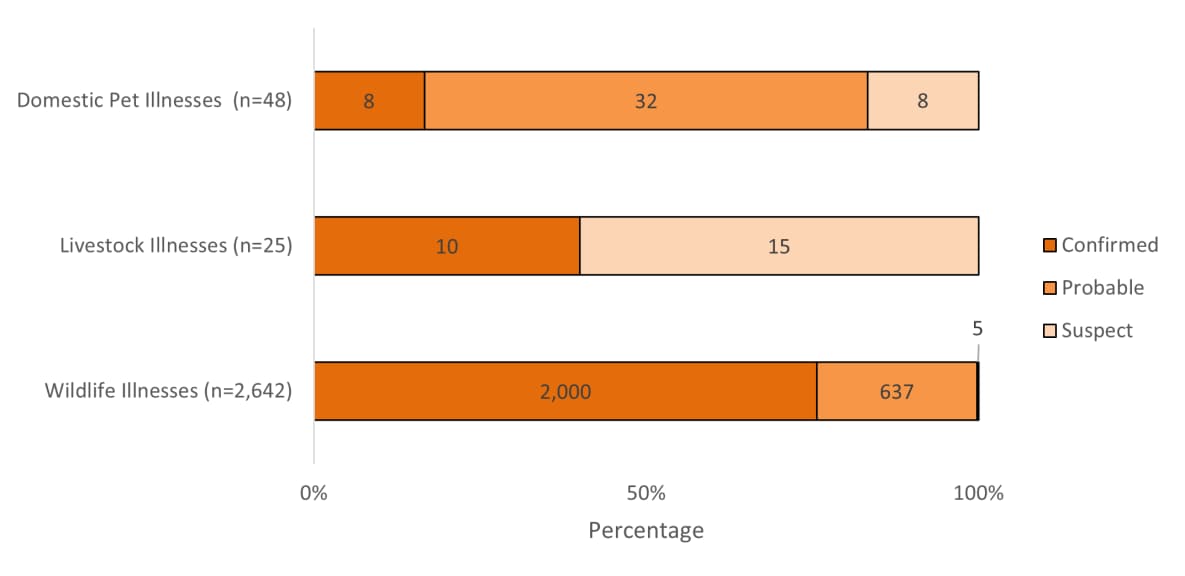
| Confirmed Frequency (%) | Probable Frequency (%) | Suspect Frequency %) | Total Frequency (%) | |
|---|---|---|---|---|
| Wildlife Illnesses | 2,000 (76) | 637 (24) | 5 (0) | 2,642 (100) |
| Livestock Illnesses | 10 (40) | 0 (0) | 15 (60) | 25 (100) |
| Domestic Pet Illnesses | 8 (17) | 32 (67) | 8 (17) | 48 (101) |
Figure 13a: Reported animal types of HAB-associated animal cases, 2021 – including a bat die off of 2,000 individuals*
Most animal illnesses reported for 2021 were associated with a wildlife mortality event affecting at least 2,000 bats. All of the domestic pet illnesses occurred in dogs and all of the livestock illnesses occurred in cattle.
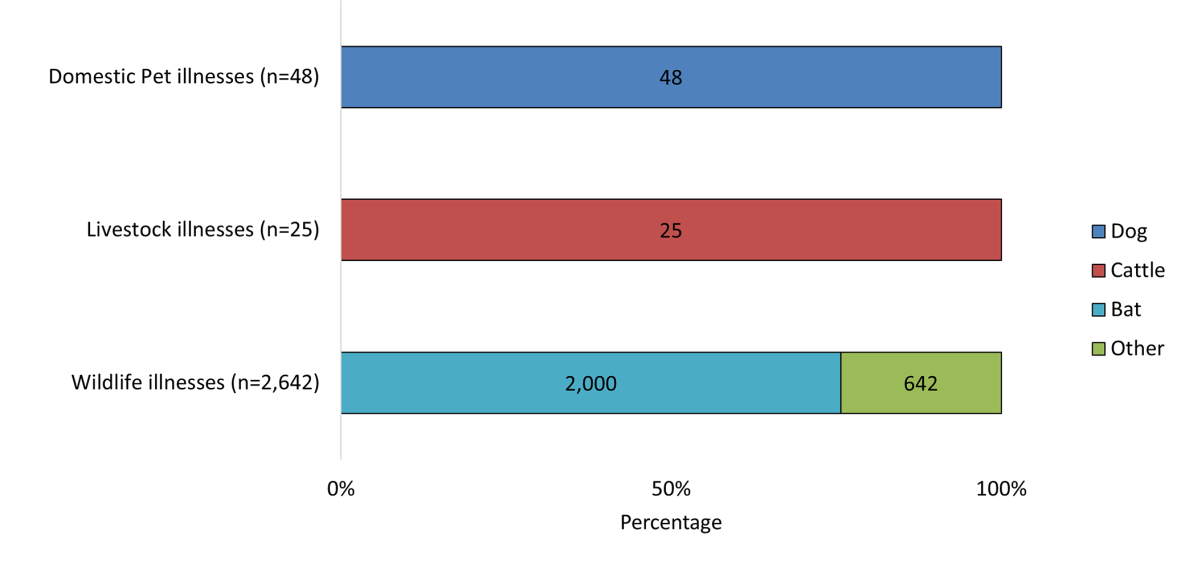
| Frequency (%) | |
|---|---|
| Individual Number of Animals Affected | 2,715 (100) |
| Domestic Pet | 48 (2) |
| Dog | 48 (100) |
| Livestock | 25 (1) |
| Cattle | 25 (100) |
| Wildlife | 2,642 (97) |
| Bat | 2,000 (76) |
| Other | 642 (24) |
* On September 12, 2023, the number of bat illnesses in Figure 13a was corrected from 2,100 to 2,000. The number of other wildlife illnesses was corrected from 542 to 642.
Figure 13b: Reported animal types of HAB-associated animal cases (excluding bat mortality event), 2021
Excluding the bat mortality event, fish were the most reported type of animal that became ill during 2021.
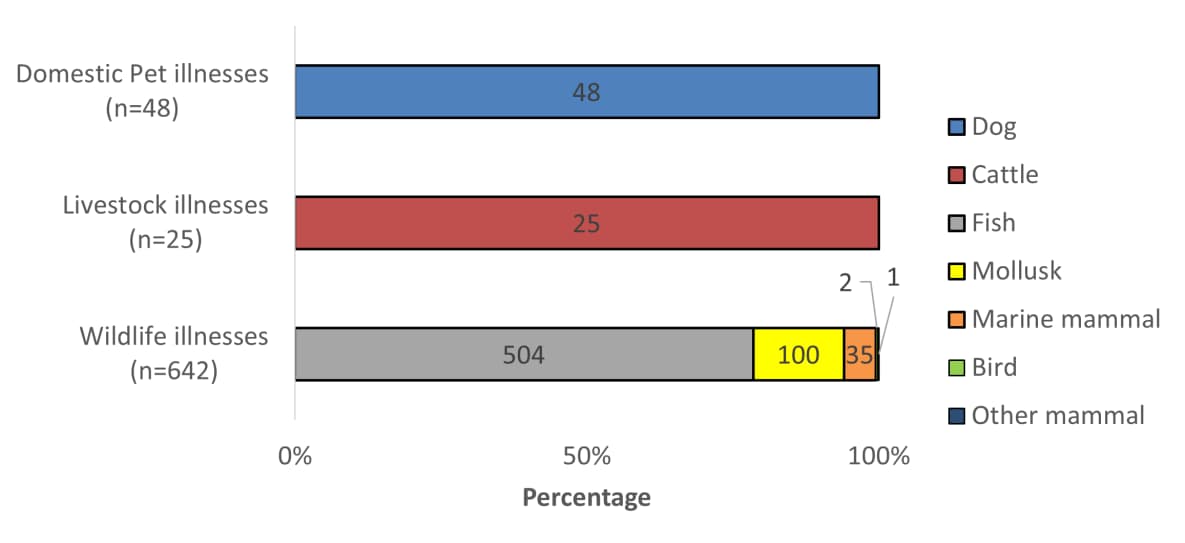
| Frequency | (%) | |
|---|---|---|
| Individual Number of Animals Affected | 715 | (100) |
| Domestic Pet | 48 | (7) |
| Dog | 48 | (100) |
| Livestock | 25 | (3) |
| Cattle | 25 | (100) |
| Wildlife | 642 | (90) |
| Fish | 504 | (79) |
| Mollusk | 100 | (16) |
| Marine Mammal | 35 | (5) |
| Bird | 2 | (0) |
| Other | 1 | (0) |
| Category | Classification | Sign | Number | (%) |
|---|---|---|---|---|
| Domestic pet | Generalized | 37 | (80) | |
| Anorexia (loss of appetite) | 8 | (17) | ||
| Anxiety | 1 | (2) | ||
| Collapse (unable to stand) | 4 | (9) | ||
| Dehydration (refusing water) | 2 | (4) | ||
| Fatigue | 1 | (2) | ||
| Fell over | 1 | (2) | ||
| Fever | 3 | (7) | ||
| Foaming at the mouth | 4 | (9) | ||
| Lethargy | 17 | (37) | ||
| Muscle tremors | 11 | (24) | ||
| Panting | 2 | (4) | ||
| Stumbling | 4 | (9) | ||
| Tremors | 1 | (2) | ||
| Weakness | 10 | (22) | ||
| Gastrointestinal | 35 | (76) | ||
| Diarrhea | 4 | (9) | ||
| Drooling/Salivation | 9 | (20) | ||
| Fecal incontinence | 1 | (2) | ||
| Regurgitation | 1 | (2) | ||
| Vomit with bile | 1 | (2) | ||
| Vomiting | 27 | (59) | ||
| Neurologic | 24 | (52) | ||
| Ataxia (stumbling, loss of balance) | 15 | (33) | ||
| Behavior change | 6 | (13) | ||
| Coma (non-reponsive to stimuli) | 1 | (2) | ||
| Confusion | 1 | (2) | ||
| Seizure/Convulsions | 5 | (11) | ||
| Cardiopulmonary | 13 | (28) | ||
| Cardiac Arrest | 7 | (15) | ||
| Cough | 1 | (2) | ||
| Labored breathing | 9 | (20) | ||
| Pale gums | 1 | (2) | ||
| Rapid breathing | 3 | (7) | ||
| Other | 9 | (20) | ||
| Head shaking | 1 | (2) | ||
| Other | 7 | (15) | ||
| Stiff limb | 1 | (2) | ||
| Genitourinary | 4 | (9) | ||
| Bladder incontinence | 4 | (9) | ||
| Dermatologic | 3 | (7) | ||
| Hair loss | 1 | (2) | ||
| Itching | 1 | (2) | ||
| Licking body | 1 | (2) | ||
| Skin lesion | 1 | (2) | ||
| Hematologic | 1 | (2) | ||
| Unusual bleeding | 1 | (2) | ||
| Ophthalmologic | 1 | (2) | ||
| Dilated pupils | 1 | (2) | ||
| Wildlife | Genitourinary | 132 | (99) | |
| Dark urine | 132 | (99) | ||
| Unknown | 2 | (1) | ||
| Unknown | 2 | (1) |
Data reported in OHHABS for 2021 are not representative of HAB event or illness occurrence in the United States because reporting is voluntary and not all states are currently reporting to this system. States may not report information for all HAB events or illnesses due to variability in surveillance capacity, surveillance program scope, or limitations to the environmental or health data available for HAB events. Environmental testing might have been limited by availability of testing for one or more toxins. Additionally, the total number of individual animals described in this report underrepresents the total affected or that died during these events because some group animal reports did not provide these numbers or indicated that the number was an underestimate. Summarized data therefore underrepresent the total number of HAB events and illnesses that occurred within or across states. Similarly, relative contributions of HAB events in salt water, toxins identified in fresh water, and types of illnesses (e.g., domestic pets versus wildlife species), may also be affected. The effects of the COVID-19 pandemic on surveillance of HAB events (e.g., bloom detection and monitoring) and illnesses (e.g., exposure to HABs, healthcare seeking behavior) are not known.
Sixteen states reported to OHHABS for 2021. The findings from this annual data summary indicate that HAB events and associated illnesses occur throughout the United States. HAB event and illness reporting primarily characterized environmental data, exposures, and outcomes associated with freshwater cyanobacterial blooms. Affected people primarily reported gastrointestinal, generalized, and dermatologic signs and symptoms, while affected animals—specifically dogs—presented with generalized, gastrointestinal, and neurologic signs. A mortality event involving at least 2,000 bats demonstrated the potential for HAB events to impact wildlife populations. Data from environmental sampling, human illnesses, and animal illnesses highlight the diversity of HAB species, toxins, and health effects associated with HAB events. A One Health approach to surveillance increases the scientific understanding and data available to characterize HAB events and inform illness prevention efforts.
CDC would like to thank state and local waterborne disease coordinators, epidemiologists, environmental health practitioners, laboratorians, toxicologists, and animal health practitioners, as well as other partners who were involved in investigating or reporting these data to OHHABS.
Centers for Disease Control and Prevention (CDC). Summary Report – One Health Harmful Algal Bloom System (OHHABS), United States, 2021. Atlanta, Georgia: U.S. Department of Health and Human Services, CDC, 2023.
Muhammad Thuneibat, Robyn Espinosa, Marissa Vigar, Taylor Jennings, Amy Jacobi, Virginia A. Roberts
